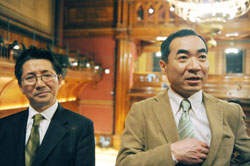Last month, comedian Mitsunori Fukuda was stopped and cited for riding a fixed-gear racing bike on a public street in Tokyo's Setagaya Ward. These bicycles, also known as "piste bikes," have become popular in the past few years, not so much as a conveyance but more as a fashion statement. They usually don't come with hand brakes, and even when they do, purchasers often remove them because they think they look more kakkō-ii (cool) that way. However, the only way to brake a proper piste bike is to peddle backward, which makes it difficult to stop quickly. For that reason, piste bikes without both front and rear brakes are illegal in Tokyo, and Fukuda's bike only had front brakes.
The citation evoked the standard apology from the comedian and his talent agency, which should have been enough to interest the show biz reporters on the morning "wide shows," but in this case the interest had less to do with the star than with the equipment, or, more precisely, the law related to the equipment. Police have never aggressively enforced traffic rules for bicycles, in particular the one that says riders must stick to roads and avoid sidewalks. Japan's roads are cramped and crowded, so police tend to look the other way regarding sidewalk riding. In the past year, however, two developments have made enforcement of traffic rules for bicycles unavoidable: the popularity of piste bikes, and the increase in bike commuters following the March 11 earthquake.
These two phenomena were picked up early by news programs. The wide shows and late-afternoon news shows often send reporters out in the field to confront citizens who are breaking the law. The most common subjects for these kinds of reports are shoplifting, illegal dumping and dangerous bike riding, and for the past several months TV news shows have aired long features on two-wheel terror in Tokyo. In many ways this ongoing coverage, most of which focuses on piste bikes, has been instrumental in bringing about the current police crackdown on reckless cyclists.



